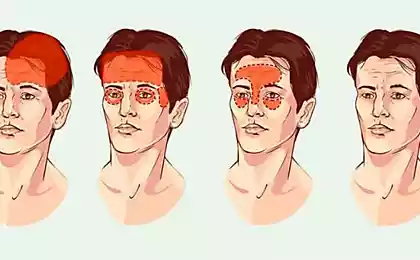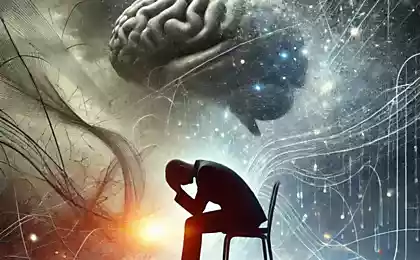454
Migraine as a psychosomatic disease
Everyone is familiar with such diseases as gastritis, ulcers, migraine, allergies, rheumatoid arthritis, asthma and hypertension. They all belong to the so-called "psychosomatic" diseases and are closely linked to internal conflicts, which are based on unconscious causes.

Drug treatment of such diseases often has only a transient effect, after which the disease returns again. Therefore, it is important to understand the causes behind these diseases to help yourself to cope with them.
Psychosomatics (ancient Greek. psycho — soul and soma — body) — the direction in psychology and medicine that studies the influence of psychological factors on the occurrence and course of somatic (bodily) diseases.
In the framework of psychosomatics examines the relationship between personality characteristics (constitutional peculiarities, traits, behavior styles, types, emotional conflicts) and one or another somatic disease.
In this article I would like to consider the migraine and the causes associated with its occurrence.
Migraine has been described since the most ancient times. Among the great men with migraine suffer, Julius Caesar, Napoleon, Alexander the great, Dostoevsky, Kafka and Virginia Woolf. Almost "unbearable" headache may last from several hours to several days.
Let us consider the basic definition of this psychosomatic illnesses. Migraine (from the Greek. hemicranias – half of the skull) manifests itself in the form of attacks hard, almost paralyzing headache, usually on one side of the head. It is believed that the disease is inherited through the female line and manifests with the onset of menstruation. The attack is often preceded by the characteristic of the patient a feeling called an aura (Latin. a breath of wind).
The attack may be accompanied:
— dizziness;
nausea;
— visual disturbances;
— vomiting;
— increased sensitivity to light and sounds.
In some cases people see sparkling dots, spheres, zigzags, lightning, fire shapes. Sometimes all objects appear enlarged, or reduced (the syndrome of Alice). The pain is pulsating, or drilling and enhanced with light and noise, increases with load and walk away. Patient strive to be alone in a dark room, closed head in the bed.
Migraine and psychosomatic causes have been extensively studied in psychoanalysis. The basics of the psychoanalytic approach to the study of the causes of migraine was laid by Sigmund Freud most of his life he suffered from migraines. Personal experience served as the basis for the creation of the psychoanalytic theories of pain. B. Luban-Plozza and co-authors noted that migraine is "the concealment of spiritual conflict." A migraine attack can give the patient the elements of the second of pleasure: it allows you to manipulate the family or to punish the world.
Some authors described the type of person prone to migraines. It turned out that for such patients is typical lagging emotional development, and advancing intellectual. They have ambition, self-restraint, dignity, sensitivity, dominance and the lack of a sense of humor. Migraines often appear in the moment when the patient comes out from under the parental wing and begins to live independently. In another study was revealed traits of these patients: the obsession, perfectionism, excessive competition, the inability to shift responsibility.
F. Alexander believed that the basis of migraine lies repressed aggression towards others and family. Able affect blood flow to the brain remains abundant and is growing. When anger is suppressed, muscle activity is blocked, blood flow to the muscles is weakened, and the flow of blood to the head becomes even stronger. This may be the physiological basis of migraine attacks. That is, at the physiological level, the body prepares to show aggression, but the individual blocks it, and physiological discharge does not occur. In the end we have a headache.
Modern American study of patients with migraines have found significant relationship between migraine and other diseases. People suffering from migraines are more likely to depression, increased anxiety and thoughts of suicide. This relationship can also be attributed to the quality of life of these patients. Attacks of headaches, lasting from several hours to several days, often cause patients to miss work or important events.
To understand yourself in the causes of migraines and other psychosomatic diseases is difficult. Here can help joint work with psychoterapia. It will help you to understand the causes of migraine and possible ways of coping with it.
To finish this article I would like a quote from Marcel Proust: "When suffering is replaced by reflection, they cease with the same force to torment our hearts". published
Author: Nataliia Boiko
P. S. And remember, only by changing their consumption — together we change the world! ©
Source: psy-practice.com/publications/psikhicheskoe-zdorove/migren_kak_psihosomaticheskoe_zabolevanie/

Drug treatment of such diseases often has only a transient effect, after which the disease returns again. Therefore, it is important to understand the causes behind these diseases to help yourself to cope with them.
Psychosomatics (ancient Greek. psycho — soul and soma — body) — the direction in psychology and medicine that studies the influence of psychological factors on the occurrence and course of somatic (bodily) diseases.
In the framework of psychosomatics examines the relationship between personality characteristics (constitutional peculiarities, traits, behavior styles, types, emotional conflicts) and one or another somatic disease.
In this article I would like to consider the migraine and the causes associated with its occurrence.
Migraine has been described since the most ancient times. Among the great men with migraine suffer, Julius Caesar, Napoleon, Alexander the great, Dostoevsky, Kafka and Virginia Woolf. Almost "unbearable" headache may last from several hours to several days.
Let us consider the basic definition of this psychosomatic illnesses. Migraine (from the Greek. hemicranias – half of the skull) manifests itself in the form of attacks hard, almost paralyzing headache, usually on one side of the head. It is believed that the disease is inherited through the female line and manifests with the onset of menstruation. The attack is often preceded by the characteristic of the patient a feeling called an aura (Latin. a breath of wind).
The attack may be accompanied:
— dizziness;
nausea;
— visual disturbances;
— vomiting;
— increased sensitivity to light and sounds.
In some cases people see sparkling dots, spheres, zigzags, lightning, fire shapes. Sometimes all objects appear enlarged, or reduced (the syndrome of Alice). The pain is pulsating, or drilling and enhanced with light and noise, increases with load and walk away. Patient strive to be alone in a dark room, closed head in the bed.
Migraine and psychosomatic causes have been extensively studied in psychoanalysis. The basics of the psychoanalytic approach to the study of the causes of migraine was laid by Sigmund Freud most of his life he suffered from migraines. Personal experience served as the basis for the creation of the psychoanalytic theories of pain. B. Luban-Plozza and co-authors noted that migraine is "the concealment of spiritual conflict." A migraine attack can give the patient the elements of the second of pleasure: it allows you to manipulate the family or to punish the world.
Some authors described the type of person prone to migraines. It turned out that for such patients is typical lagging emotional development, and advancing intellectual. They have ambition, self-restraint, dignity, sensitivity, dominance and the lack of a sense of humor. Migraines often appear in the moment when the patient comes out from under the parental wing and begins to live independently. In another study was revealed traits of these patients: the obsession, perfectionism, excessive competition, the inability to shift responsibility.
F. Alexander believed that the basis of migraine lies repressed aggression towards others and family. Able affect blood flow to the brain remains abundant and is growing. When anger is suppressed, muscle activity is blocked, blood flow to the muscles is weakened, and the flow of blood to the head becomes even stronger. This may be the physiological basis of migraine attacks. That is, at the physiological level, the body prepares to show aggression, but the individual blocks it, and physiological discharge does not occur. In the end we have a headache.
Modern American study of patients with migraines have found significant relationship between migraine and other diseases. People suffering from migraines are more likely to depression, increased anxiety and thoughts of suicide. This relationship can also be attributed to the quality of life of these patients. Attacks of headaches, lasting from several hours to several days, often cause patients to miss work or important events.
To understand yourself in the causes of migraines and other psychosomatic diseases is difficult. Here can help joint work with psychoterapia. It will help you to understand the causes of migraine and possible ways of coping with it.
To finish this article I would like a quote from Marcel Proust: "When suffering is replaced by reflection, they cease with the same force to torment our hearts". published
Author: Nataliia Boiko
P. S. And remember, only by changing their consumption — together we change the world! ©
Source: psy-practice.com/publications/psikhicheskoe-zdorove/migren_kak_psihosomaticheskoe_zabolevanie/
9 plants that will help to lose weight
The white house is worried about the fate of bees and butterflies























